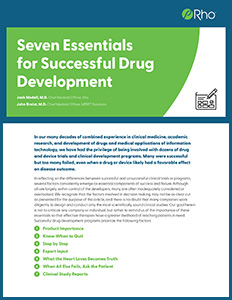 Far too often clinical development programs fail, even when a drug or device likely had a favorable effect on disease outcome. There is considerable need for increased recognition of the factors contributing to the costly problem of failed drug and device development programs. This article distills these factors into seven basic essentials:
Far too often clinical development programs fail, even when a drug or device likely had a favorable effect on disease outcome. There is considerable need for increased recognition of the factors contributing to the costly problem of failed drug and device development programs. This article distills these factors into seven basic essentials:
1. Develop a product that truly meets a therapeutic need
2. Terminate a clinical development program quickly when data show a risk-benefit ratio unlikely to be favorable
3. Design each study to provide meaningful information to guide the next step(s) of product development
4. Use expert input adequately and appropriately
5. Avoid false assumptions about trial requirements based on what worked or didn’t work in the past
6. Recognize limitations of rater objectivity
7. In clinical study reports, regulatory submissions, and regulatory interactions, we must tell the truth, the whole truth, and nothing but the truth
